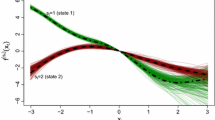Abstract
The estimates of total advertising impact and of its mean duration in distributed lag models are important in budgeting and planning decisions. The typical approach to assessing the short and long term impact of advertising is to perform a sequential test, one on the short term coefficient and one on the lag parameter. However, estimate of the effect of advertising on sales involves the ratio of estimated regression parameters. The estimates of these parameters are known to be correlated. Generation of confidence intervals on such key estimates is possible, using information that is typically discarded. This paper develops and illustrates a method for developing these confidence intervals which specifically accounts for the correlation between the standard regression estimates. Examples are used to illustrate that the conclusion from standard sequential testing procedures can be erroneous. An empirical application then demonstrates the application of the suggested procedure. Finally, we provide insights on the length of this interval as the sample size and other characteristics are varied.
Similar content being viewed by others
References
Bass, Frank M. and Robert Leone. 1981. “Temporal Aggregation, the Data Interval Bias and Empirical Estimation of Bi-monthly Relations from Annual Data.” Working Paper. West Lafayette, IN: Krannert Graduate School of Management, Purdue University.
Bultez, A. V. and P. A. Naert. 1979. “Does Lag Structure Matter in Optimizing Advertising Expenditures?”Management Science 25: 454–465
Clarke, Darral G. 1976. “Econometric Measurement of the Duration of Advertising Effects on Sales.”Journal of Marketing Research 13: 345–357.
Crane, M. A. and A. J. Lemoine. 1974.An Introduction to the Regenerative Method for Simulation Analysis. New York: Springer-Verlag.
Dhrymes, P. J. 1971.Distributed Lags: Problem of Estimation and Formulation. Holden Day.
Hayduk, L. A. 1987.Structural Equation Modelling with LISREL. Baltimore: The John Hopkins University Press.
Hansen, Morris H., W. N. Hurwitz, and W. G. Madow. 1953.Sample Survey Methods and Theory. New York: John Wiley & Sons.
Helwig, Jane T. and Kathrun A. Council. 1979.SAS User’s Guide. SAS Institute.
Johnson, R. M. and D. W. Wichern 1982.Applied Multivariate Statistical Analysis. Engelwood Cliffs, NJ: Prentice Hall.
Johnston, J. 1972.Econometric Methods. New York: McGraw Hill.
Koyck, L. M. 1954.Distributed Lags and Investment Analysis. Amsterdam: North Holland Publishing.
Lambin, Jean Jacques. 1972. “Is Gasoline Advertising Justified.”Journal of Business 45: 505.
Lambin, Jean Jacques. 1976.Advertising, Competition and Market Conduct in Oligopoly Over Time. Amsterdam: North-Holland.
Maddala, G. S. 1977.Econometrics. McGraw-Hill.
Magat, W. A., J. M. McCann, and R. C. Morey. 1986. “When Does Lag Structure Really Matter in Optimizing Advertising Expenditures?”Management Science 32: 182–193.
Morey, R. C. and J. M. McCann. 1983. “Estimating the Confidence Interval for the Optimal Marketing Mix: An Application to Lead Generation.”Marketing Science 2: 193–202.
Moriarty, M. M. and J. L. Lastovicka. 1985. “Time Interval Bias: Its Impact on Advertising Budgeting.” InCurrent Issues and Research in Advertising, 1985, Volume 1: Original Research and Theoretical Contributions, pp. 115–128. Eds. J. L. Leigh and C. R. Martin. The University of Michigan.
Roy, S. N. and R. F. Potthoff. 1958. “Confidence Bounds on Vector Analogues of the ‘Ratio of Means’ and the ‘Ratio of Variances’ for Two Correlated Normal Variates and Some Associated Tests.”Annals of Mathematical Statistics 29: 829–841.
Simon, Julian. 1969. “The Effect of Advertising on Liquor Brand Sales.”Journal of Marketing Research 6.
Weiss, Doyle L. and Pierre M. Windal. 1980. “Testing Cumulative Advertising Effects: A Comment on Methodology.”Journal of Marketing Research 17:371–378.
Author information
Authors and Affiliations
Rights and permissions
About this article
Cite this article
McCann, J.M., Morey, R.C. & Raturi, A.S. Confidence interval for the total advertising impact and its mean duration under Koyck models. JAMS 19, 333–340 (1991). https://doi.org/10.1007/BF02726508
Issue Date:
DOI: https://doi.org/10.1007/BF02726508




